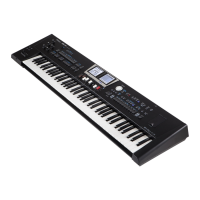81
20. Working with the 16-Track Sequencer
Your BK-9 contains a powerful 16-Track sequencer with a host of
edit functions. This sequencer allows you to record MIDI data and is
therefore not available for WAVE recordings.
Important Things Before Using
16-Track Sequencer.
• The 16-Track sequencer does not recognize changes made to
a song using the “SMF MAKEUP TOOLS” functions. It only “sees”
the original song data. You can, however, use the Freeze Data
function to modify the song le before you start editing it. See
“To commit your changes (Freeze Data)” (p. 101).
• The 16-Track sequencer can be used to record onto 16 tracks
sequentially (one track at a time).
• The 16-Track sequencer can also be used to edit existing songs.
To do so, simply select an SMF song (p. 44), then select the
16-Track sequencer page.
• Tracks are assigned to MIDI channels on a 1:1 basis (i.e. Track 1=
MIDI channel 1,… Track 12= MIDI channel 12, etc.).
• In addition to the 16 “music” tracks, there is a “MASTER” track. It
is used for recording the time signature, the tempo, as well as
general SysEx data.
Selecting the 16-Track Sequencer
1. Press the [MENU] button, rotate the dial to select “16Track
Sequencer”, then push the dial.
The displays change to:
Left Display
Right Display
About the sequencer’s main pages
Left display
In this page you can select the track to play, record or edit. The rst
tone in the track is shown.
In the rst row the song name is shown.
Right display
This page shows the tracks (1~16) in the song. The horizontal bars
indicate that tracks contain musical data.
Right Display
If you look at the example above, you will notice a little arrow on
top of the horizontal bars. The little arrow refers to the current
position of play or record pointer within the song (which is also
indicated in the “M:xxx.x” eld). The horizontal bars indicate that a
track contains musical data in that position.
Now look again at the illustration: only the tracks that contain note
data that are not muted have the “*” symbol.
MUTE & SOLO function
The MUTE function allows you to temporarily switch o the
selected track, which may be useful when you want to record or
edit additional parts without being distracted by already existing
parts.
The SOLO function allows you to listen to the selected track in
isolation (it mutes all other tracks).
a. To mute a track, select it and press the [TRACK MUTE]
button.
b. To listen to the track in isolation, select the track and
press and hold the [TRACK MUTE] button.
Soloed tracks are agged with an “S”, while muted tracks use
the letter “M”.
Recording a Song from Scratch
If you have already played back a song since switching on the BK-9,
the song internal memory already contains data we need to erase.
Initialize a Song
1. From the 16-Track Sequencer main pages press the
[QUICK MENU] button.
The left display changes to:
Left Display
2. Use the dial to select “Initialize Song”.

